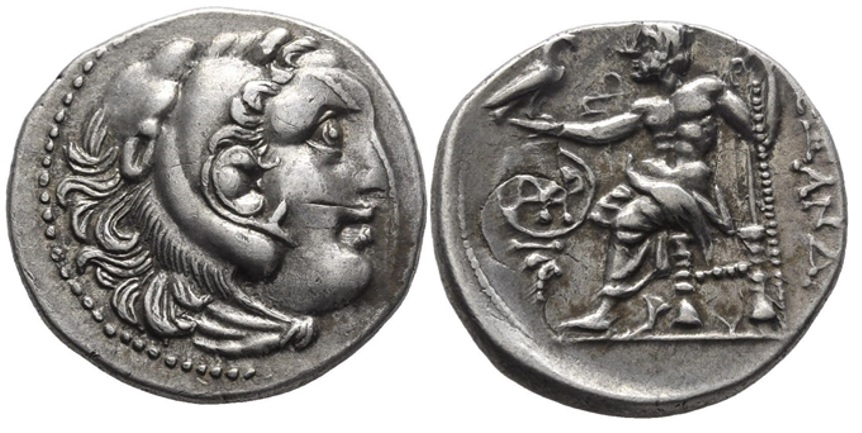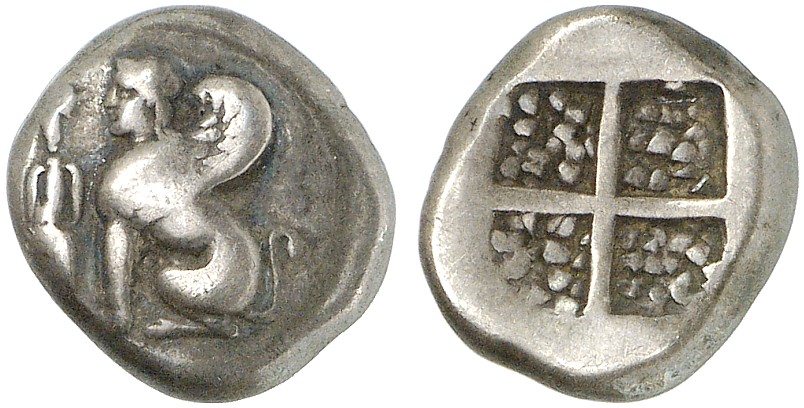3012 - Chios (Alexander the Great) (drachm Heracles/Zeus) over Chios (Sphinx/incuse square) (Ebay Lanz, Aug. 2018): Difference between revisions
From SILVER
m (Callatay moved page SO 781 - Chios over Chios to 781 - Chios (Alexander the Great) (tetradrachm) over Chios (Lanz, Aug. 2018)) |
No edit summary |
||
| Line 1: | Line 1: | ||
{{Overstrike | {{Overstrike | ||
|Sale=Lanz on Ebay | |Image overstriking coin=Chios SO 781.jpg | ||
|Image overstruck variety=Chios 391.jpg | |||
|Sale=Lanz on Ebay, 25 Aug. 2018 | |||
|Obverse description=Head of Herakles right, wearing lion skin headdress. Border of dots. | |Obverse description=Head of Herakles right, wearing lion skin headdress. Border of dots. | ||
|Reverse legend=AΛΕΞANΔΡΟΥ | |Reverse legend=AΛΕΞANΔΡΟΥ | ||
|Reverse legend language=Greek | |||
|Reverse description=Zeus enthroned left, holding eagle and scepter. In field, monogram (MYPO) and grapes. | |Reverse description=Zeus enthroned left, holding eagle and scepter. In field, monogram (MYPO) and grapes. | ||
|Mint=Chios | |Mint=Chios | ||
|Ancient region=Ionia | |Ancient region=Ionia | ||
|Authority=Alexander III the Great (Argead king, 336-323 BC | |Authority=Alexander III the Great (Argead king, 336-323 BC) | ||
|Date from=290 | |Date from=290 BCE | ||
|Date to=275 | |Date to=275 BCE | ||
|Period=Hellenistic | |||
|Metal=Silver | |||
|Weight=4.08 | |Weight=4.08 | ||
|Diameter=19 | |Diameter=19 | ||
|Denomination= | |Denomination=drachma | ||
|Standard=Attic | |Standard=Attic | ||
|Coin series reference= | |Coin series reference=Price 1991, n° 2325 | ||
|Overstruck obverse description=Sphinx | |Coin series web reference=http://numismatics.org/pella/results?q=2325 | ||
|Overstruck obverse description=Sphinx seated left, amphora surmounted by bunch of grapes before | |||
|Overstruck reverse description=Quadripartite incuse square | |||
|Overstruck mint=Chios | |Overstruck mint=Chios | ||
|Overstruck ancient region=Ionia | |Overstruck ancient region=Ionia | ||
|Overstruck date from=380 BCE | |||
|Overstruck date to=330 BCE | |||
|Overstruck period=Classical | |||
|Overstruck denomination=drachma | |Overstruck denomination=drachma | ||
|Overstruck standard=Attic | |||
|Coin series reference overstruck=Sear II, n° 4603; Hardwick 1991; HGC 6, n° 1124-1125 | |||
|Coin series web reference overstruck=https://greekcoinage.org/iris/id/chios_hardwick_1991_local_350-330 | |||
|Frequency of overstrikes=rare and concentrated | |||
|Level of confidence=weak | |||
}} | }} | ||
Revision as of 18:45, 3 May 2023
290 BCE - 275 BCE | AΛΕΞANΔΡΟΥ
Location/history
| Sale(s)Sale(s) ᵖ: | Lanz on Ebay, 25 Aug. 2018 | |
Overstriking coin
Description
| ObverseInscription or printing placed on the obverse.: | Head of Herakles right, wearing lion skin headdress. Border of dots. | ReverseInscription or printing placed on the reverse.: | AΛΕΞANΔΡΟΥ (Greek) Zeus enthroned left, holding eagle and scepter. In field, monogram (MYPO) and grapes. |
Mint and issuing power
| MintIdentifies the place of manufacture or issue of a numismatic object.: | Chios | Ancient regionAncient region. | Ionia | Modern countryModern country: Greece | AuthorityIdentifies the issuing power. The authority can be "pretended" when the name or the portrait of X is on the coin but he/she was not the issuing power. It can also be "uncertain" when there is no mention of X on the coin but he/she was the issuing power according to the historical sources: | Alexander III the Great (Argead king, 336-323 BC) |
Chronology
| FromIdentifies the initial date in a range assigned in a numismatic context. 290 BCE toIdentifies the final date in a range assigned in a numismatic context.. 275 BCE | Hellenistic 323-30 BC |
Physical description
| MetalThe physical material (usually metal) from which an object is made.: Silver |
WeightWeight of the numismatic object (in grams). in grams: 4.084.08 g <br />4,080 mg <br /> | DenominationTerm indicating the value of a numismatic object. Examples: tetradrachm, chalkous, denarius.: drachma |
|
| DiameterDescribes diameter of an object (in mm).: 1919 mm <br />1.9 cm <br /> | StandardStandard.: Attic | ||
References
| Coin referenceReference of the Coin: | Coin series referenceReference to coin series study: | Price 19911Price 1991, n° 2325 | |
| Coin series web referenceCoin series web references: | |||
Overstruck type
Description
| ObverseInscription or printing placed on the obverse.: | Sphinx seated left, amphora surmounted by bunch of grapes before | ReverseInscription or printing placed on the reverse.: | Quadripartite incuse square |
Mint and issuing power
| MintIdentifies the place of manufacture or issue of a numismatic object. ᵖ: | Chios | Ancient regionAncient region. ᵖ | Ionia | Modern countryModern country: Greece | AuthorityIdentifies the authority in whose name (explicitly or implicitly) a numismatic object was issued. ᵖ: |
Chronology
| FromIdentifies the initial date in a range assigned in a numismatic context. 380 BCE toIdentifies the final date in a range assigned in a numismatic context.. 330 BCE | Classical 480-323 BC |
Physical description
| DenominationTerm indicating the value of a numismatic object. Examples: tetradrachm, chalkous, denarius. ᵖ: | drachma |
StandardStandard. ᵖ: | Attic |
References
| Coin type referenceReference to coin series study ᵖ: | Sear II2Sear II, n° 4603, Hardwick 19913Hardwick 1991, HGC 64HGC 6, n° 1124-1125 | ||
| Coin series web reference overstruckCoin series web references overstruck: | |||
Additional data
| Frequency of overstrikesFrequency of overstrikes: | rare and concentrated | Level of confidenceLevel of confidence of the identification: | weak |
| RemarksRemarks: | |||
References
- ^ Price, Martin Jessop (1991), The Coinage in the Name of Alexander the Great and Philip Arrhidaeus: a British Museum Catalogue, 2 vol., Zürich-London, 637 p., 637 p., clix pl.
- ^ Sear, David R. (1979), Greek coins and their values. Vol. II, Asia and North Africa, London, xlviii, p. 317-762
- ^ Hardwick, Nicholas (1991), The coinage of Chios from the sixth to fourth century B.C., Oxford, unpublished DPhil, xvi + 316 p.
- ^ Hoover, Oliver D. (2010), The Handbook of Greek Coinage Series, volume 6 : handbook of coins of the islands: Adriatic, Iionian, Thracian, Aegean, and Carpathian seas (excluding Crete and Cyprus), sixth to first centuries BC, Lancaster, 358 p.

